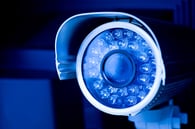 Demand for infrared optical elements has extended beyond just lens assemblies and hot/cold mirrors. Specifically, there is growing interest across the optical industry for bandpass filters, achromats, athermal elements, and polarizing waveplates. The demand spans all IR wavelength bands—near IR (0.75 µm to 1.4 µm), short-wavelength IR (1.4 µm to 3 µm), mid-wavelength IR (3 µm to 8 µm), and long-wavelength IR (8 µm to 15 µm). Advances in sensor and source technology, as well as a changing marketplace, are driving this growth. Demand from three industries stands out as particularly noteworthy:
Demand for infrared optical elements has extended beyond just lens assemblies and hot/cold mirrors. Specifically, there is growing interest across the optical industry for bandpass filters, achromats, athermal elements, and polarizing waveplates. The demand spans all IR wavelength bands—near IR (0.75 µm to 1.4 µm), short-wavelength IR (1.4 µm to 3 µm), mid-wavelength IR (3 µm to 8 µm), and long-wavelength IR (8 µm to 15 µm). Advances in sensor and source technology, as well as a changing marketplace, are driving this growth. Demand from three industries stands out as particularly noteworthy:
Security Systems / Access Control
Illumination from near-IR security systems is invisible to the human eye making these systems more difficult to avoid or disable. The increased power and efficiency of near-IR LED sources is extending the field-of-view and range of infrared security systems. The market research company Memoori forecasts that the security market will reach a value of $7.85Bn by 2022.
Remote Thermal Measurement
Thermal sensors, known as pyrometers, measure the heat emitted from objects as infrared radiation, from short wavelengths of 1.6 µm to long wavelengths of 12 µm. Long-wavelength IR sensors can measure temperatures from as low as 75° F to as high as 1000° F, although with limited precision. Short-wavelength IR sensors have superior precision but are limited to temperature measurements between 550° F through 1000° F. Although there are other heat-measurement methods, such as thermocouples, infrared pyrometers are expected to continue to dominate the market because they are non-contact and thus can operate at a distance from the monitored object, enabling them to measure temperature ranges that a thermocouple could not survive.
Night Vision
There are three primary forms of night vision equipment on the market—active IR illumination, image amplification, and thermal imaging—each with distinct advantages and disadvantages that we will explain in a future post. A BusinessWire report anticipates the night vision market will grow to $12.24 billion by 2022 (from $6.74 billion in 2016) with a 10.4% compound annual growth rate. Factors driving growth include improved technology, falling prices, and wide-ranging demand across consumer, commercial, and defense markets.
Although other factors affect demand (e.g., overall global economy, defense budgets, etc.), the three industries described above are driving market expansion for optical elements across all IR bands. The need for specific optical products will vary depending on the relative growth of these industries. During this time of change, it is even more important to follow the principles of practical optical design and to use best-practices when choosing optical materials that might be new to you.
Give us a call to talk to one of our engineers about your IR optical design and learn how Ross may be able to help.
Our free guide includes cost considerations for optical systems, mechanical and coating design, and designing with specialty optics. Download it now!




